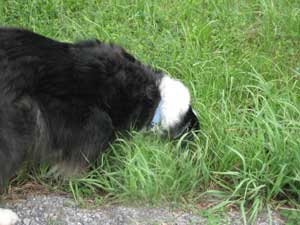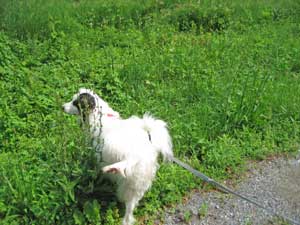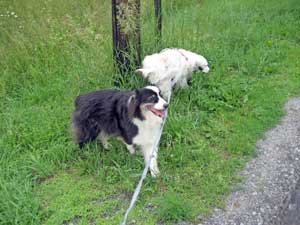
Loosely, it’d be like you trying to catch up with your favorite bloggers, but every time you’d get to one of their latest posts and wanted to leave a comment someone would yank your laptop away.
One of the main reasons my dogs love their walks so much is because they’re allowed to read the Doggy Gazette from cover to cover, to their heart’s content. But what exactly is the “Doggy Gazette” and why is it completely normal for dogs to want to “read” and “write” it? And why should you reconsider, if you haven’t been allowing time for your dog to stay current with the local news?
You probably already know that dogs have millions more scent receptors than we do, and that the way they process smells is very different than the way we do. If we let ourselves fully grasp that about 33% of a dog’s brain is devoted to processing olfactory information (in humans it’s only about 5%), it’s not hard to understand that, for dogs, smell may be just as important if not more so than sight. Without question, it’s a primary source of information collecting for them.

If given the right circumstance, pretty much all dogs will urine mark, but males are more likely to mark than females, and unneutered males are more likely to mark than neutered males (especially in the presence of females or rival males). Unspayed females will mark, especially right before and while they’re in heat, to broadcast their availability. But even spayed females sometimes urine mark. (Kiera is a world-class scent marker.) It’s the more dominant dogs of either sex that often engage in “overmarking”–urinating in the same spots where other dogs have left a scent.

Some dogs scent mark by urinating small amounts on vertical surfaces, usually while raising a leg. Both female and male dogs can urine mark. Dogs who urine mark might do so in a number of situations, including while on walks, when in their own homes and yards, and during visits to other locations. A dog must be at least three months of age to urine mark.
Reproductively Intact Dog
Dogs who are reproductively intact (unspayed females and unneutered males) are more likely to urine mark than spayed or neutered dogs. In unspayed females, urine marking usually happens more frequently just before and while they’re in heat.
Something New in the Environment
Some dogs urine mark when they encounter nonresident dogs in their environments or smell urine left in their environments by other dogs. A dog’s environment may encompass his home, his yard, the route he usually takes when on walks, friends’ homes he regularly visits, and parks or other locations he frequents.
Social Triggers
Exciting social situations can trigger urine marking. Some male dogs only urine mark when in the presence of female dogs (especially if they’re in heat), and some urine mark only when interacting with other male dogs. Some dogs only urine mark when visiting homes where other dogs have urine marked before. Other dogs only urine mark when they become highly aroused and over-stimulated in social situations. These dogs often mark nearby objects, people or other dogs.
Anxiety
Some dogs urine mark when they experience anxiety. Anxious dogs might deposit greater amounts of urine than dogs marking for other reasons. They might also urine mark on spots that aren’t vertical surfaces. A number of events can cause anxiety and trigger urine marking, including the presence of new objects, furniture or luggage in a dog’s environment, the departure of a resident from a dog’s home, a new person moving into the home, and conflict between a dog and people or other animals in the home.
Marc Bekoff came up with a novel way to investigate his dog’s marking behaviors. You can read about it in his article, “Yellow Snow Can Tell Us About What a Dog’s Nose Knows.” In it, he talks about how dogs are able to distinguish T-shirts worn by identical twins, follow odor trails, and are 10,000 times more sensitive than humans to certain odors.”
He also explains that “Scent-marking” is differentiated from “merely urinating” by a number of criteria that include sniffing before urinating followed by directing the stream of urine at urine that is already known to be present or at another target.”Odors are powerful stimulants,” Bekoff adds. “Although my late companion dog, Jethro, enjoyed visiting his veterinarian, he showed fear if he went into an examination room where the previous canine client was afraid.”
Another interesting aspect of a dog’s smell, as Steven R. Lindsay writes, is that “Olfactory information is highly durable in dogs. They exhibit evidence of recognizing the scent of the mother and the breeder after years of separation, social memories that may persist throughout a dog’s life.”
Bottom line: both smelling and marking is hard-wired in dogs, and a key component of how they interpret and move through their world. So the next time you’re ready to take your dog for a walk, try to leave time for your dog to peruse the Doggy Gazette. Your dog will thank you for it.
PS: One of my readers brought up a good point about those times when you want your dog to heel. I should explain that my dogs know the difference between a “Gazette” walk and a “Heads Up — Right Beside Me” walk. Much of that is determined by where we’re walking. On my country road, they’re allowed to whiz away. In town, it’s “pay attention, stay close, and all legs down.”

Peggy, thanks so much for your kind words. : ) I’m hoping to have a book on dog intelligence out in a couple of months. The book I’m working on now is about a wild coyote. Thanks for asking!
Just read DOGS OF DREAMTIME–loved it—-When are you going to write another book????
:-)
Hey Meredith! Good to see you. Yes, we have a similar “popular” training method by an old-fashioned punitive trainer in the US — who’s name shall not grace my pages. And if someone truly has a problem dog– aggressive, etc.–then a keen eye on the dog and a consistent hand on the leash is probably warranted. But that’s not what this post is talking about.
And I should explain that my dogs know the difference between a “Gazette” walk and a “Heads Up — Right Beside Me” walk. Much of that is determined by where we’re walking. On my country road, they’re allowed to whiz away, like your girl in the woods. In town, it’s “stay close and all legs down.”
What makes me sad about the type of trainer who is all about “Me master — you prisoner” is that they don’t seem to realize that dogs can and will adapt their behaviors to different circumstances, if trained well with understanding. (Actually, I’m betting they do realize it, but don’t feel their human clients would be able to be consistent enough in how they trained their dogs — so it’s one-size-fits all training.)
This goes against a popular training method for dog walking in France where the master is not supposed to let the dog do whatever he/she wants but enforce the “heel and continue alongside me” method. Something about showing the dog who is in charge. But since I walk in the woods and my dog just runs free wherever she wants, it’s obviously not a method I enforce.